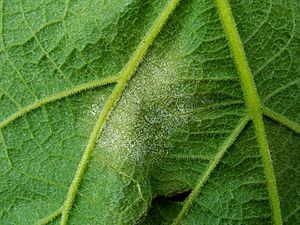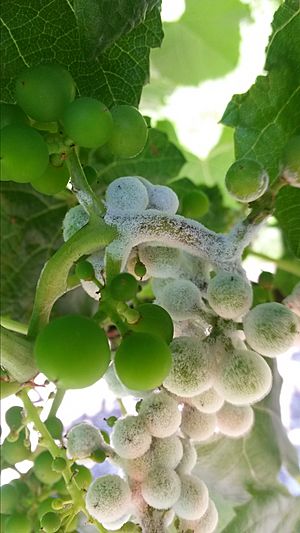Plasmopara viticola facts for kids
Quick facts for kids Plasmopara viticola |
|
|---|---|
 |
|
| Scientific classification | |
| Genus: |
Plasmopara
|
| Species: |
viticola
|
| Synonyms | |
|
|
Plasmopara viticola, the causal agent of grapevine downy mildew, is a heterothallic oomycete that overwinters as oospores in leaf litter and soil. In the spring, oospores germinate to produce macrosporangia, which under wet condition release zoospores. Zoospores are splashed by rain into the canopy, where they swim to and infect through stomata. After 7–10 days, yellow lesions appear on foliage. During favorable weather, the lesions sporulate and new secondary infections occur.
Contents
Description
Plasmopara viticola, also known as grape downy mildew, is considered to be the most devastating disease of grapevines in climates with relatively warm and humid summers. It was first observed in 1834 by Schweinitz on Vitis aestivalis in the southeastern United States. Shortly after this first observation, the pathogen was introduced to European countries where it played a devastating role in the yield and production of their grapes, and consequently their wine. France was among the first of the European countries to gain experience in dealing with the pathogen. Within just a few years of the pathogen's introduction the French attempted to graft American root stock to their own vines in order to produce a more resistant strain of grape. Depending on the year, production of grapes in France has been estimated to have been reduced by as much as 50%. Because of numbers and results like these, downy mildew has been considered the most devastating disease of a filamentous pathogen to affect European vineyards. When comparing three grape producers in Europe, including some fields that were treated with fungicides or other management strategies, the economic losses ranged from ~2000 euros per hectare to ~4250 euros per hectare.
Symptoms cover a fairly large range depending mostly on the host. Common symptoms include necrosis of the stem or shoot, discoloration including brown spotting (lesions) and yellowish-green tips of the leaves. Grapes may exhibit sporangia and sporangiophores, appearing as white to gray coat on the outer surface.
Downy mildew has a specific set of environmental conditions to reproduce and infect. A warm, moist, and humid environment is required. Studies in Sicily have shown optimum time for oospore germination is between the end of February and the middle of March. With this understanding, if fungicides are used just before optimum conditions occur, they have proven to be an effective control method of the pathogen. Other control methods include proper watering, and a good location where the plant can receive continual sunlight.
Hosts and symptoms
The hosts of Plasmopara viticola includes the species Vitis vinifera and all cultivars within the species. It also can affect any interspecific hybrids within the Vitis genus. There is also some susceptibility in the Vitis labrusca species, ranging from highly susceptible to resistant. The European cultivar is most susceptible to the pathogen, as it lacks evolutionary resistance that the American varieties have, because the pathogen originated in the Americas and was later transmitted into Europe. North American species are also susceptible but varies from high susceptibility to resistance. In the regions with high annual rainfall, the grapevines may suffer more from this disease.
Leaves
The first symptom of downy mildew of grapes usually can be seen on leaves after 5 to 7 days of primary infection. Early in the season (spring), Yellow circular spots with oily appearances is going to present on foliage along with the veinlets. Note that, in some red grape varieties, the spots may in red color. The young oil-spots are surrounded by brown-yellow halos. As the oil-spots get mature, the halo would fade. As the oil spots age and develop, infected tissue would become necrotic and nonreproductive, due to cell death. If under appropriate weather conditions, a larger number of oil-spots can develop, expand, and cover most of the leaf surfaces.
After a warmer and humid night, a white downy fungal growth (sporangia) would be abundant on the downsides of the leaves and other infected plant areas. The severely infected portion could die. Severely infected leaves may drop from the plant.
The pathogen may also attack the old leaves in late summer. The infected old leaves may present a mosaic pattern with yellow to red-brown spots on the upside of the leaves' surface.
Other parts
The shoots of the plant can also be infected and shown as the same oily patches. After a warm humid night, these oily patches may also sporulate and be covered with white fungal growth. The shoots are may also be distorted or curled after infection.
The grape fruits may also have the symptoms in the later season. The infected berries would turn brown, wither, and then die finally. The infected green fruit may turn light brown and purple. White fungal growth(sporulation) can abundant on the grapes during humid weather. Infected grapes are easy to detach from the pedicles. However, the fruits become resistant to infection around 2–3 week after blooming, excluding the rachis. The rachis becomes resistant only around 2 months after blooming.
If the young bunch stalk is infected, oily brown sites can be seen. The infected inflorescence or bunches would wither rapidly. Infected inflorescence would eventually turn to brown, which means the death of the bunches.
Note that, berries become resistant to infection after 2 to 3 weeks after bloom, other parts of the plants may remain susceptible 2 months after bloom.
Cultural management
Reduce the risk of disease when establishing the vineyards. This practice includes choosing the location, drainage, soil, and irrigation system.
Avoid the distribution of infected soil and plant tissue from equipment. Carefully clean the equipment or change equipment after used in the infected areas. Also, carefully clean the boots or clothes after entering the infected areas.
Canopy management practices, such as low planting density, vine trimming, and hedging, and later shoot thinning, can improve the air movement and make the leaves drier.
Genetic resistances
Investigating in wild grape varieties to increase the genetic resistance. Develop the breeding of disease-resistant cultivars. Resistant cultivars can be useful and efficient to avoid infection.
Monitoring
Automatic weather stations can be established for monitoring and predicting weather events. Collecting data from temperature, rainfall, leaf wetness, and humidity.
Chemical control
Pre-infection fungicides prevent the zoospores to enter the leaf stomates. Also, post-infection fungicides can be used as soon as possible after infection to kill the pathogen tissues inside the leaves. Chemical pesticides are useful methods to control this pathogen and downy mildew.
Biological control
Biological agents, like Epicoccum nigrum link, can inhibit the spread of spores of Plasmopara viticola. Microorganisms can be used to biocontrol plant disease. However, microbial control agents do not work well.
Taxonomy
In 1848, Berkeley and Curtis made reference to a downy mildew on grapevines, and, in a footnote, named it Botryis viticola. However, Botryis viticola was a nomen nudum. It was later transferred to Peronospora and then to Plasmopara. In 1907, Wilson erected Rhysotheca with P. viticola as the type; however, the name Rhysotheca viticola never caught on. In 1946, a strain on Vitis amurensis was raised to the species level as P. amurensis. In 1955, Golovina named the varieties americana, aneurensis, and parthica. In 1951, Alice Săvulescu and Traian Săvulescu named the formae speciales viniferae-ampelopsidis, aestivalis-labruscae, and silvestris based on host and morphology. Later authors synonymized all these names back into P. viticola. A population level analysis of P. viticola from the United States of America revealed the presence of four lineages that correspond to the host that could be distinguished based on molecular phylogenetics, morphology, and cross-inoculation experiments: P. viticola f. sp. quinquefolia, P. viticola f. sp. vinifera, P. viticola f. sp. aestivalis, and P. viticola f. sp. riparia. Further study recognized an additional lineage: P. viticola clade vulpina. The lineage Plasmopara f. sp. quinquefolia has been named Plasmopara muralis.
See also
 In Spanish: Plasmopara viticola para niños
In Spanish: Plasmopara viticola para niños


